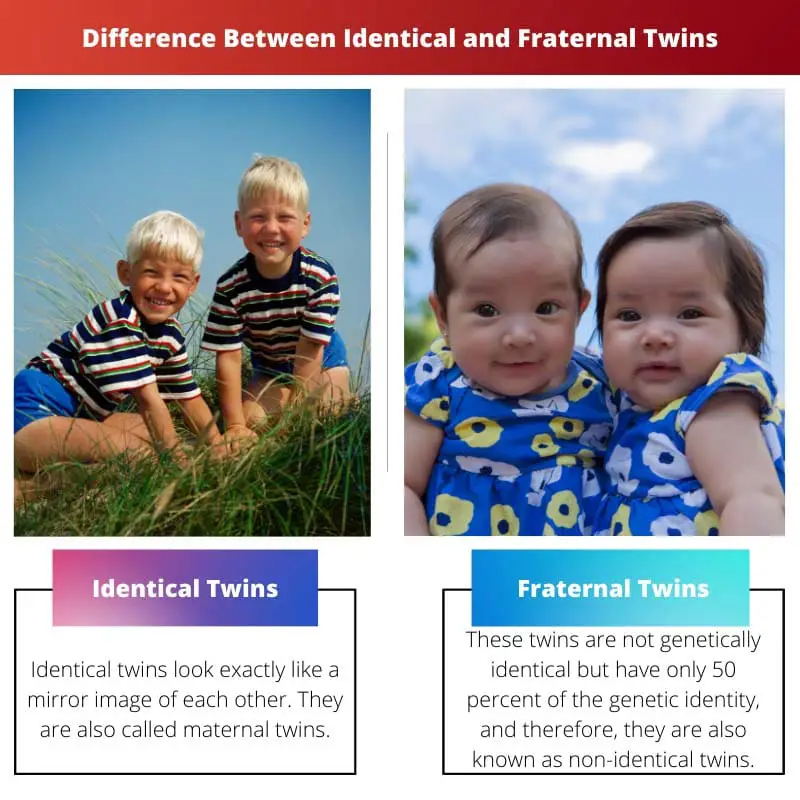Most of the women get pregnant with one baby, while some get pregnant with two, three, four, or even more than that at a time.
This mostly depends upon genetic factors, but it is also possible a couple gets pregnant with more than one baby for the first time in the family history.
Conceiving two babies is known as twins. This is not very rare but not as common as well. Mostly, twins look similar with several of the same features, and for a stranger, it is difficult to distinguish between them.
There are two types of twins: identical twins and fraternal twins. Both of them are similar but more different at the same time.
Key Takeaways
- Identical twins originate from a single fertilized egg, while fraternal twins develop from two separate eggs.
- Identical twins share 100% of their genetic material, whereas fraternal twins share about 50%.
- Identical twins have the same physical characteristics, but fraternal twins can display significant differences in appearance.
Identical vs Fraternal Twins
Identical twins are babies that are born when the fertilized eggs of a woman are divided into two parts, so they share the same placenta and look alike when born. Fraternal twins are twins born when two separate eggs of a woman get fertilised, and although they are born together, they look different.

In identical twins, the fertilized eggs of the women get divided into two parts within a few days of conception, and the reason behind calling them monozygotic is that they are formed from the same zygotes.
The fertilized eggs split and then developed into two babies, and as they originally belonged to the same eggs, both of them may share the same placenta. It is a less common type of twin.
Fraternal Twins are types of twins born with different eggs. It happens when two eggs of the women get fertilized by the sperm. They are called dizygotic as they are formed with two different zygotes.
Usually, one egg is fertilized, but in this case, two eggs of the woman fertilize, which results in two babies, and as babies are born with different eggs, they also have different placentas. These types of twins are common.
Comparison Table
| Parameters of Comparison | Identical Twins | Fraternal Twins |
|---|---|---|
| Also called | Monozygotic Twins | Dizygotic Twins |
| Formed by | Forming several fetuses. | Separate fertilisation |
| Placentas | May be Same | Different |
| Chorionicity and Amnionicity | Can be Di-Di twins and other twins (Mono-Di, Mono-Mono, etc.) | Only Di-Di Twins |
| Hereditary | Not hereditary | Hereditary |
What are Identical Twins?
Identical twins look exactly like a mirror image of each other. They are also called maternal twins.
Around 1 in 333 pregnancies, there is a chance of identical twins as they are not formed due to any hereditary factor and hence not passed down in genes. Fewer women can have identical twins when fertilized eggs get split.
There is a high chance that both babies share the same placenta.
They can be Di-Di Twins, where embryos are split after 3 to 2 days of fertilization; Di-Mono Twins, where embryos are split after 3 to 8 days of fertilization, Mono-Mono Twins, where embryos are divided after 8 to 13 days of fertilization, and lastly Conjoined Twin where embryos division take place after 13 days of fertilization.
There is a high chance that babies, in this case, have joined body parts.
Both babies share identical chromosomes as they are formed from the same egg and sperm. Also, there is a high chance they have the same eye color and other physical characteristics as well.
They may have the slightest difference due to the environmental factors they are birthing in.

What are Fraternal Twins?
These twins are not genetically identical but have only 50 percent of the genetic identity, therefore, they are also known as non-identical twins.
Most twins belong to this type of twins as they are born due to hereditary factors. Twins born as fraternal can be of different sex. Therefore, they can be Boy and boy, girl and girl, and girl and boy.
The most interesting fact about fraternal twins is that babies can also belong to two different people or, in simple terms, have two different gatherings. This happens when the eggs get fertilized by different sperm.
It is rare but a fact. There is also a chance that both of the babies might not be born on the same day.
They are the result of hyperovulation. It was a condition when women released more than one egg. They are common in Africa and rare in Asia.
The embryos in this twin also split after 2-3 days of fertilization. It is easy to distinguish between babies in this as they can be of different sex and characteristics.

Main Differences Between Identical and Fraternal Twins
- In terms of genetic identity, both of them are different as identical twins born from the same egg carry identical genomes, whereas fraternal twins born from different eggs but the same female have only 50% identical genomes.
- In terms of appearance, identical twins are alike; it is comparatively more difficult to distinguish between them, whereas fraternal twins are like siblings that can be differentiated relatively easily.
- They also differ when it comes to sexes, where again the fertilized eggs play the vital role, as identical twins share the same part of eggs, therefore, both of them have same-sex along with the same blood group, while different eggs may also lead to different or same-sex and different blood groups in case of fraternal twins.
- Identical twins are less common as they are not due to hereditary factors they can happen to any woman, and therefore, only one-third of the twins are identical, whereas fraternal twins are always hereditary, which is common, and hence two-thirds of the twins are fraternal.
- Some Twins are more likely to suffer from TTTS, which is a twin-to-twin syndrome that can be life-threatening to one or both babies, this syndrome is more likely to develop in identical twins, whereas there is a low risk of TTTS in Fraternal Twins.

- https://jamanetwork.com/journals/jamapsychiatry/article-abstract/491444
- https://psycnet.apa.org/record/1937-04406-000
- https://jamanetwork.com/journals/jamapsychiatry/article-abstract/490991
- https://link.springer.com/article/10.1007/BF01070219
- https://jamanetwork.com/journals/jamapsychiatry/article-abstract/493164



